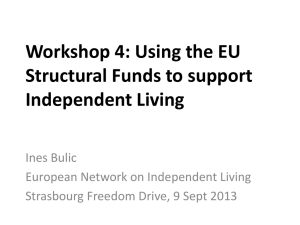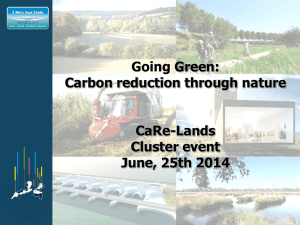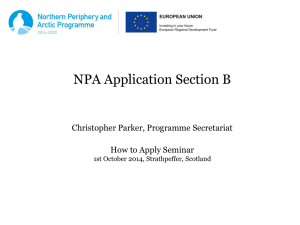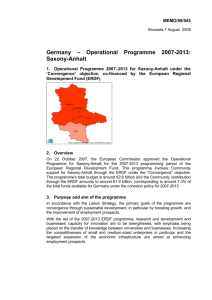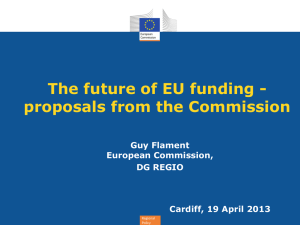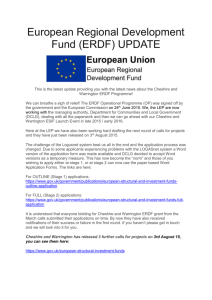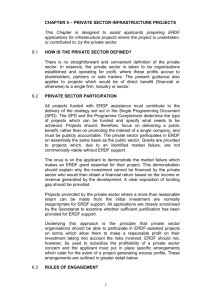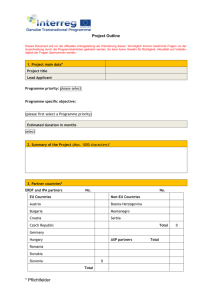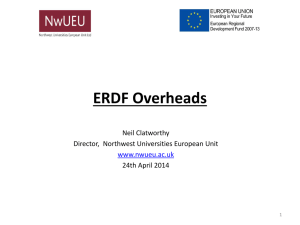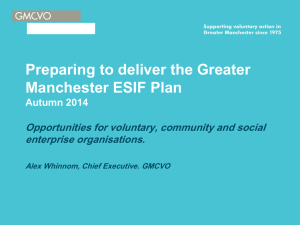Full application form guidance
advertisement
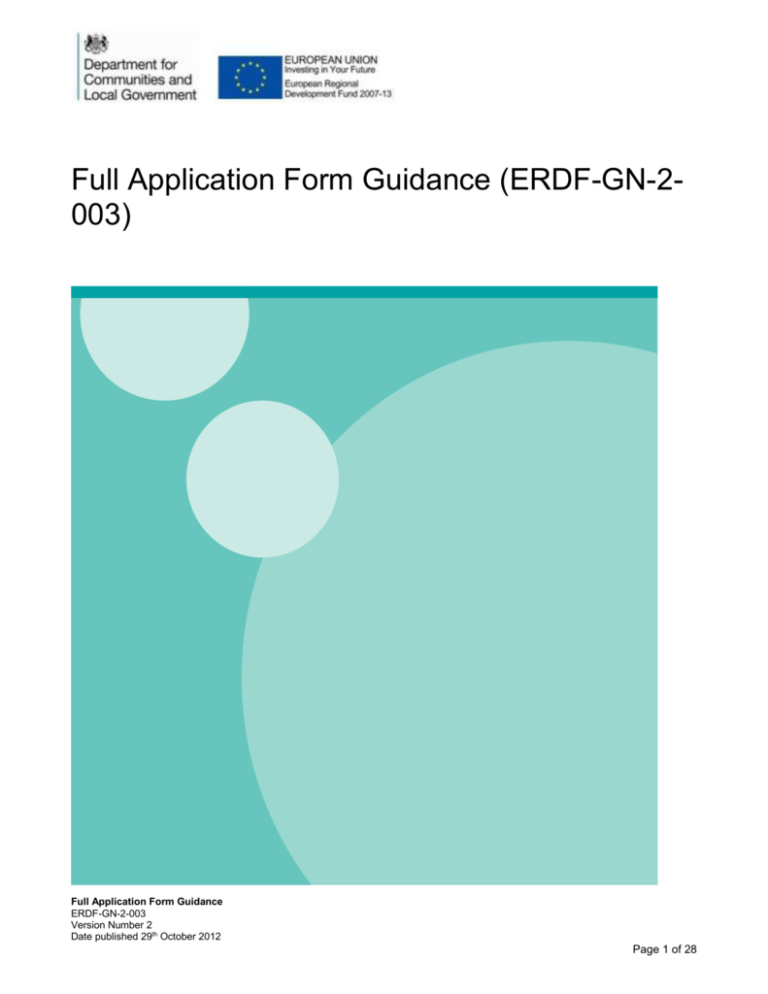
Full Application Form Guidance (ERDF-GN-2003) Full Application Form Guidance ERDF-GN-2-003 Version Number 2 Date published 29th October 2012 Page 1 of 28 Related Documents Outline Application Form Full Application Form Full Application Checklist OA Indicators, Costs & Funding Annex FA Indicators & Financial Annex ERDF-Forms-2-001 ERDF-Forms-2-007 ERDF-Forms-2-009 ERDF-Forms-2-002 ERDF-Forms-2-008 Full Application Form Guidance ERDF-GN-2-003 Version Number 2 Date published 29th October 2012 Page 2 of 28 Introduction The development of a robust full application is an important element of any project, essential for the approval of funding and as an evolving tool to measure, control and evaluate delivery. The full application should capture information on the rationale, activities, costs and outcomes of a project. The guidance set out in this document follows the structure of the Full Application Form, and is intended to form the basis of information needed to prepare a robust project proposal. It is recommended that judgement is applied to the use of this information. In particular the guidance should be interpreted proportionately to the size and complexity of the project. The length of the full application will depend on the scale, complexity and duration of a project, with multi-party, complex and lengthy projects requiring more detail than smaller projects. The style of the full application should always remain factual and informative, with minimal opinions or generalisations - bullet points, illustrations and tables are likely to be more effective than prose. In a robust and complete full application, there should be references throughout the document to evidence statements made, some of which may be appropriate to append, where not publicly available. These may include economic data and reports, Government or industry guidance, and independent verification (e.g. state aid guidance and verification, financial reviews, valuations and accreditations). Applicants are advised to refer to the relevant Operational Programme document and associated prospectus when developing their full application to ensure adherence to ERDF requirements. What you need to do Before completing the Full Application form, you are recommended to familiarise yourself with: The Prospectus which accompanies the Call for Proposals. The Prospects sets out the requirements you need to consider when completing the application. The National ERDF Handbook. This describes the application, selection and approval process and compliance, monitoring and audit requirements of the 2007-13 ERDF programme. The National Eligibility Rules, ERDF State Aid Law Requirements, The National Procurement Requirements, ERDF Publicity Requirements, ERDF Article 55 Revenue Generating Projects' Requirements The guidance documents on the website (particularly those which relate to your regional programme including the Operational Programme and Outputs/Results guidance). Full Application Form Guidance ERDF-GN-2-003 Version Number 2 Date published 29th October 2012 Page 3 of 28 Before submitting the full application, complete the Full Application checklist (ERDFForm-2-009) and attach, along with all the required supporting information, to the application. If you have any questions, please contact your ERDF PDT. A Identification The information provided here should be the same as that provided at Outline Application stage. B Applicant Declaration & Certification The Full Application must be signed by a senior person in the project applicant organisation who has the authority to make binding legal agreements on its behalf. Ensure that the name is printed and their position within the organisation is clearly stated e.g. Chief Executive, Financial Director. Part 1 C Project Summary Applicants are advised to complete the Project Summary of no more than 200 words once they have finalised all the information required for the Full Application. The summary should précis the content of the full application and should not contain new information. D Project Details Project Sound Bite In one sentence (30 words) tell us what your project will do and what it will achieve, ensure it is SMART. For example: This project will reduce costs for 100 SMEs by reducing manufacturing waste by 10% by June 2015. This information will be used by DCLG for publicity purposes. Project Location Details should be provided of the location of the beneficiaries of the project. For capital projects, applicants must provide the address, including the postcode, of the actual site and/or development. Full Application Form Guidance ERDF-GN-2-003 Version Number 2 Date published 29th October 2012 Page 4 of 28 Project Start Date Financial Completion Date Practical Completion Date Project Funding Summary The date the project is scheduled to start, claims can be made and activity can be monitored and reported in line with ERDF requirements. The date by which all eligible project costs are defrayed The practical end date is the date at which the project completes activity including the realisation and verification of all outputs and results. Include details of the total value of ERDF requested along with total value of public and private match funding. If your project is a mix of capital and revenue activities, you must identify these separately. If you are applying for funding in the NW or Y&H in both the competitiveness and the Phasing In part of each region, the amounts must be identified separately. These figures must be consistent with those provided in section 3.3 of Part 2 of the Full Application. Where the ERDF project is part of a larger project, with ineligible ERDF costs, include the overall project value. E Outline Conditions At the Outline Application stage, you may have been advised of a number of conditions that should be met at the Full Application stage. In the left column, list each of the outline conditions then in the right column provide a summary explanation as to how each condition has been met, cross referencing where necessary to relevant sections of the Full Application. Add additional rows as necessary. F Key Changes since Outline Application If necessary, applicants should use this table to highlight any significant changes to the project since the Outline Application was selected, particularly if such changes relate to cost, indicators or scope of project activity. Reasons and justifications for such changes should be included. Please refer to the relevant PDT for details as to what might constitute a significant change. Add additional rows as necessary. G Project Applicant Project Applicant The name of the lead organisation applying for ERDF and which will be the “accountable body” for the project Address of applicant The address of the project applicant organisation Full Application Form Guidance ERDF-GN-2-003 Version Number 2 Date published 29th October 2012 Page 5 of 28 organisation including post code Contact Person The person responsible for the project during the application process. Position in organisation Position of contact person within the project applicant organisation Email: Email address of the contact person Telephone Number Type of organisation Direct telephone number of the contact person Use one of the following codes to describe the applicant organisation 01 NDPB, other bodies & organisations within central government This includes central government departments and their agencies including Trading Funds, Non-departmental public bodies, NHS Health Authorities and Boards. 02 Local Authorities All tiers of local government, police and fire authorities, transport authorities, greater London Authority (GLA), state schools and colleges except City Technology Colleges and City Academies. 03 Public Corporations These are public trading bodies which have a substantial degree of financial independence from the public authority which created them. Examples are Post Office, Transport for London, Royal Mint, Land Registry, British Nuclear Fuels. 04 Private Sector Not for Profit Institutions These are non-profit institutions serving households. These include bodies such as charities, universities, churches, trade unions or members clubs, National Trust. If an SME, the applicant must define the category of SME in the box below. 05 Private Sector Companies Private sector companies are taken to be organisations established and operating for profit. If an SME, the applicant must define the category of SME in the box below. If applicable: Define category of SME Using the EUs definition, define the category of SME and identify the ownership structure (micro, small, medium) http://ec.europa.eu/enterprise/policies/sme/facts-figures-analysis/smedefinition/index_en.htm Registered Number (company or charity) Company of Charity Registration Number VAT Number The VAT number of the project applicant organisation Website The website of the project applicant organisation Full Application Form Guidance ERDF-GN-2-003 Version Number 2 Date published 29th October 2012 Page 6 of 28 H Delivery Partners If the project is to be delivered by a group of partners, provide full details for each delivery partner by copying and pasting the table in section H. The project applicant, ie the organisation leading the bid and submitting this application will be fully responsible and therefore financially liable for any ERDF. Further information on partnership projects and lead partner requirements can be found in the National ERDF Handbook. If there have been any changes to delivery partners since the Outline Application was selected, these should be listed in Section F and all relevant details for the new and/or additional delivery partners provided in Table H. Part 2 1 STRATEGIC FIT 1.1 Project Objectives What are the projects objectives? These need to be clearly stated and should be SMART (Specific, Measurable, Achievable, Realistic and Time bound). Explain how you will measure if the project has been successful, i.e. what will be its impact? If any of the objectives have changed since the project was selected at the Outline Application stage this must be explained under the section on ‘key changes’ under section F. Any significant changes to the objectives may warrant the need to reassess the whole project or may not be accepted for appraisal. 1.2 Project Description This section should identify the main elements required to deliver the main project objectives contained in section 1.1. Describe the project in detail and how it will operate. Explain: what the project intends to do Full Application Form Guidance ERDF-GN-2-003 Version Number 2 Date published 29th October 2012 Page 7 of 28 where the project is to be delivered geographically and the rationale for the scope and/or limitations to the area of delivery when it will be delivered and why it is appropriate to progress this project at this time, describe any links to existing, past or planned projects who will be involved and benefit; specify which groups the project will target and outline the specific benefits to them. how it will be delivered what the ERDF funding will be spent on. 1.3 Support for the ERDF Operational Programme and relevant local, regional, national and European plans Explain how the project fits with the requirements of the relevant Operational Programme priorities and any criteria specified in the relevant Prospectus. Describe how the project supports other relevant European, national, regional and local strategies and/or plans and/or projects. 1.4 Support for the environment and sustainability theme Explain: how the proposal meets the requirements of the environmental sustainability themes for the relevant Operational Programme what impact this project will/may have on the environment, economy and/or social sustainability if any adverse effects have been identified, and if so, explain how they will be managed/mitigated throughout the delivery of the project. All projects awarded ERDF funding must comply with EC environmental legislation, which seeks to ensure that projects do not have adverse effects on the environment. EC environmental legislation also requires that projects that are likely to have significant effects on the environment shall be subject to an assessment of those effects. For some types of projects, an assessment is mandatory, while for others it depends on whether the project is judged to have significant effects on the environment. Member States are required to give the EC, where appropriate, information about the environmental impact of measures for which funding is sought. Full Application Form Guidance ERDF-GN-2-003 Version Number 2 Date published 29th October 2012 Page 8 of 28 In preparing the project application, it may be necessary to consult a competent environmental authority, depending on the nature of the project deliverables. 1.5 Support for the Equality and Diversity theme All applicants must explain how their proposal contributes to, and meets the requirements of, the equality and diversity theme for their relevant Operational Programme. Projects must demonstrate commitment towards addressing equality issues and meet the highest quality standards, exceeding baseline legislative requirements wherever possible. Equality should be integrated into all aspects of project planning, development, implementation, monitoring and evaluation. It must be embedded not only within the services the project provides, but also in the way the project is run. In this section, applicants must clearly set out: who the intended beneficiaries are. what if any consultation has been undertaken with representative stakeholders. the impact this proposal will have on different groups. how adverse impacts, unfair disadvantage or exclusion will be mitigated and monitored throughout the project, including actions put in place to address these (including reasonable adjustments to ensure equal access for disabled people). how opportunities for positive impact to encourage participation by under-represented or protected groups, and promotion of equality, have been identified and maximised. whether the proposal is a property, capital build or infrastructure project and how legal accessibility requirements will be met, and where possible, exceeded. Applicants will be expected to supply a copy of their equality policy (see Full Application Checklist). Some LMCs have agreed additional requirements including the need to complete a ‘Screening Equality Impact Assessment Form’ and where applicable a Full Equality Impact Assessment. This will be clearly set out in the relevant prospectus - applicants should check with their local PDT to see what applies in their area. Further guidance is available in the National ERDF Handbook and advice can be obtained from your PDT. Full Application Form Guidance ERDF-GN-2-003 Version Number 2 Date published 29th October 2012 Page 9 of 28 2 RATIONALE AND ADDITIONALITY 2.1 The need for the project and evidence of Market Failure Explain why this project is needed. Describe the problem that the project is intended to solve, identify the baseline of the market or provide a description of the current state of the economic, social and/or environmental conditions the project is aims to address. If the project is exploiting an opportunity, describe what it is and explain what benefits can be achieved. Explain why the project should be funded by the public sector in general. What is preventing the private sector from solving this problem / exploiting this opportunity? 2.2 The demand for the project Explain who wants this project? Provide evidence to demonstrate this demand. The full application will need to identify and evidence that beneficiaries will use the service and that it does not simply displace other activity available in the market place (i.e. by an SME using the product/service, will this mean another provider is losing that business?). The demand and need evidence may require some form of objective and independent verification where the findings are contentious or the overall project size is significant. Depending on the size of the project, this could take the form of a report from a third party – either an independent study, or a verification of in-house findings. It would be useful to refer to such reports and documentations in the full application and append them to the full application in order to strengthen the case being made. The inclusion of references to public documents and websites is also essential. 2.3 Options Analysis Using the template in Annex 1 of the Full Application Form, provide an Options Analysis. The options considered should be able to meet all or the majority of the project objectives. Applicants are expected to develop at least two further options - a ‘do nothing’ option and one alternative viable option, alongside the preferred option (which is the detailed project described in the full application). For major investments, a comprehensive range of options should be considered. Full Application Form Guidance ERDF-GN-2-003 Version Number 2 Date published 29th October 2012 Page 10 of 28 Option (a) – Do Nothing Brief Description: For example: Describe the option in 30 words. No ERDF investment to address the need identified. SMEs will be required to pay for the service in full, without public subsidy. Main Advantages: For example: Use bullet points to summarise the main advantages of this option. Main Disadvantages: Use bullet points to summarise the main disadvantages of this option. Impact on Costs: Use bullet points to summarise the impact on costs of this option, taking into account any impacts on other projects as well. Impact on Deliverables: Use bullet points to summarise the impact on deliverables of this option, taking into account any impacts on The money could be invested in other projects with a higher impact for OP priorities. Potential distortion of the market would be nil. For example: SMEs will not take up the support without public subsidy, and business growth will be lower as a result. Opportunities that would have been catalysed by this project will not be developed, or will be developed elsewhere, to the detriment of the locality. 100% fewer jobs will be created. 100% fewer businesses will improve their performance. For example: There will be no ERDF funding required. Failure to invest now is likely to result in costs for this type of project increasing in future due to lost synergies with other projects. This impact has been estimated at c.30% in re-start costs. For example: There will be no ERDF outputs or results delivered. There will be a consequential impact on other complementary activity (such as MAS and Business Coaching for Growth) which this project is expected to refer SMEs to. This is likely to reduce the effectiveness (and deliverables) of these projects by c.10%. Full Application Form Guidance ERDF-GN-2-003 Version Number 2 Date published 29th October 2012 Page 11 of 28 other projects as well. Overall risk of this option (H/M/L): For example: This option will release ERDF to invest in other projects. However, this option will have a negative consequential impact on MAS and Business Coaching for Growth. Describe the risks and constraints associated with this option, and rate the option. As a result, this option is rated as MEDIUM risk. Reasons for rejection: For example: Summarise the reasons for rejecting this option in favour of your preferred option This option has been rejected as it does not address the market failure identified in section 2.1, and will have a negative consequential impact on projects such as MAS and Business Coaching for Growth. Option (b) – Alternative viable option Brief Description: For example: Describe the option in 30 words A grant scheme only (i.e. no diagnostic support) providing up to 50% subsidy for SMEs to access external expertise to improve their energy efficiency. Main Advantages: For example: Use bullet points to summarise the main advantages of this option. Main Disadvantages: Use bullet points to summarise the main disadvantages of this option. The project could flexibly respond to a wide variety of needs and market opportunities. Potential distortion of the market would be reduced as SMEs would choose their own supplier. For example: This approach does not address the information gap identified – i.e. SMEs do not know what support is available or how to access it. Without expert diagnosis, ERDF and SMEs are likely to pay a higher cost for external expertise. Full Application Form Guidance ERDF-GN-2-003 Version Number 2 Date published 29th October 2012 Page 12 of 28 Impact on Costs: For example: Use bullet points to summarise the impact on costs of this option, taking into account any impacts on other projects as well. Impact on Deliverables: For example: Use bullet points to summarise the impact on deliverables of this option, taking into account any impacts on other projects as well. Overall risk of this option (H/M/L): When the cost of providing advice is taken into account, this option is likely to result in an extra 12% cost, due to poorer investment decisions being taken by SMEs. This option will result in 12% fewer SMEs assisted, 12% fewer businesses assisted with improved energy efficiency, 15% fewer jobs safeguarded, and 15-20% lower GVA. This option will also negatively impact on the outputs and results of the MAS service, as the referral mechanism between the two projects will not be funded. This is estimated at 5% of costs. For example: Describe the risks and constraints associated with this option, and rate the option. This option will release £200,000 ERDF to invest in other projects. However, this option will have a negative consequential impact on MAS and Business Coaching for Growth. As a result, this option is rated as MEDIUM risk. Reasons for rejection: For example: Summarise the reasons for rejecting this option in favour of your preferred option Whilst this project addresses the affordability of external energy efficiency support, this option has been rejected as it does not address the information gap identified in section 2.1, and will have a negative consequential impact on projects such as MAS and Business Coaching for Growth. Option (c) – Additional option Brief Description: Describe the option in 30 words Full Application Form Guidance ERDF-GN-2-003 Version Number 2 Date published 29th October 2012 Page 13 of 28 Main Advantages: Use bullet points to summarise the main advantages of this option. Main Disadvantages: Use bullet points to summarise the main disadvantages of this option. Impact on Costs: Use bullet points to summarise the impact on costs of this option, taking into account any impacts on other projects as well. Impact on Deliverables: Use bullet points to summarise the impact on deliverables of this option, taking into account any impacts on other projects as well. Overall risk of this option (H/M/L): Describe the risks and constraints associated with this option, and rate the option. Reasons for rejection: Summarise the reasons for rejecting this option in favour of your preferred option Full Application Form Guidance ERDF-GN-2-003 Version Number 2 Date published 29th October 2012 Page 14 of 28 2.4 The Preferred Option Explain why the preferred option was selected over the others. The Full Application should also highlight any further work required to progress the preferred option(s). This may include areas of high risk, uncertainty, or assumptions to be tested. Additionality – the need for ERDF support 2.5 Explain how the project meets the principle of ‘additionality’. Additionality is a core principle of ERDF. This principle exists to ensure that funding from the European Commission is not used merely to replace funding earmarked for projects by existing agencies and authorities in the UK but brings added value over domestic funding. An activity would not be considered additional if the funding was, for example, necessary to meet statutory provision or requirements, or was intended to replace other funding. The contribution of ERDF to a project must add value to new or existing activity. Projects need to demonstrate that the activity paid for by ERDF would not have taken place in this form without ERDF support. The basic criterion for additionality is that projects should be supported only to the extent that: the project would not proceed in any form without ERDF support; or ERDF support will allow a project to proceed within a shorter timescale; and / or ERDF support will allow a project to proceed at a higher level of quality and impact. For further guidance on additionality, see section 4 and Annex 1 of the National ERDF Handbook. 3 PROJECT SCHEDULE, AND DELIVERABLES 3.1 Project Schedule Describe and/or provide a Gantt chart to show the timing of project activities and their interdependencies, both internal and external to the project which should show as a minimum: Timing and interlinking of the tasks Project start date Project end date Full Application Form Guidance ERDF-GN-2-003 Version Number 2 Date published 29th October 2012 Page 15 of 28 Key milestones (these may include the examples given below, but are not restricted to them): o Funding Approval o Contract Signature (if applicable) o Key deliverable milestones o Completion of deliverables o Completion of benefits monitoring o Payments Complete (note possible retentions for capital projects) o Project Close o Independent project audit and evaluation Please ensure that both capital and revenue milestones are included. Using the tabular format below, describe all the key deliverable milestones. Milestones measure the progress of a project, and should be used as a tool to monitor delivery of the project. They should relate directly to the activities of the project, as well as costs, outputs etc, and will be included in the Funding Agreement. They must therefore be of good enough quality for the PDT to monitor the project. Milestones should be as clear, detailed and specific as possible to allow them to be effectively monitored. Phase Deliverables Activities & Milestones Quality Criteria Responsible person Date achieved by Phases These are the different stages of the project as it is being delivered. These could cover either phases over time, or concurrent activity strands. Examples of phases are: - Project set up phase - this would include activities around recruitment of staff, establishing systems and processes. Building phase - this would be the time developing a site, until practical completion. Monitoring phase - this would be once the delivery (building or revenue activity) has been completed, but while outputs etc. are still being monitored. Closure phase - this would be to close the project down (possibly there may be milestones about sustainability etc). Full Application Form Guidance ERDF-GN-2-003 Version Number 2 Date published 29th October 2012 Page 16 of 28 - Others may include Pre-project start-up, Design, Launch, Construction, Management and Monitoring, Project Delivery, Sub-contract/tendering, Year 1, Evaluation. Deliverables These are the main things that will be delivered as a result of the project, and will relate to the project objectives. For example - Sub-contract, Tendering, Recruitment, Staffing Structures, Marketing, Promotion, Project Delivery, Activities, Events, Work Completion, Fit-out works, Final completion works, Audit, Reporting/Compliance, Evaluation (to include Interim and Final) etc, etc. Activities and Milestones These are the tasks that will be monitored to ensure that the deliverables are being worked towards. They will relate to the deliverable, and can be as many as necessary. The reporting milestones and any contractual requirements are to be included in this table. Quality criteria This is the quality required of the activity or milestone, to enable the PDT to be satisfied that it has been completed in line with the agreed requirements. Responsible Person This is the person who is responsible for ensuring that the activity/milestone is completed to the correct quality criteria. Date achieved by This is the date by which time the milestone or activity should be completed. Where there is more than one date for an activity, this should be put here also. 3.2 Project Deliverables: Outputs and Results All projects should complete the Indicator Table in the Deliverables, Costs and Funding Annex (ERDF-Forms-2 -008). Use the table to set out the projects targets for the outputs (measures of activity) and results (what that activity is expected to produce over the life of the project) that will be achieved in each year of the projects lifetime. Each Operational Programme has established Programme specific indicators and associated targets. Applicants should refer to the relevant OP and prospectus (replace O1, O2, R1, R2 etc with the relevant indicator code identified in the relevant prospectus). If successful, grant recipients may need to set up new systems to collect the data needed to provide evidence of progress towards the agreed targets. Full Application Form Guidance ERDF-GN-2-003 Version Number 2 Date published 29th October 2012 Page 17 of 28 Outputs and results will be measured using data collected from funded projects. Information on how outputs and results have been calculated and the reasoning for that methodology must be included in this section. Projects are required to collect this indicator data and report on progress on a claim-by-claim basis. The targets provided should be realistic. If the project is approved, failure to deliver the agreed targets could result in grant being withdrawn and/or repaid. It may not be appropriate to set a target for every item listed in every year. Targets should be set in the year in which the project would expect to achieve those targets. This is especially true for indicators that take 12 months to identify and evidence. An example of how to explain and clearly show how indicator targets will be evidenced and monitored is shown below. Code Indicator Description Target Measure Target Rationale/Calculation Methodology Evidence of progress/achievement of target Responsible owner Output 1 Number of start-up businesses receiving Priority 1 assistance 100 Number of start-up businesses Based on targets achieved in existing project Registration & confirmation of support received by end beneficiary Provider x Result 1 Number of jobs created (FTE and by gender) 12 Number of new jobs created (M/F) Based on targets achieved in existing project Confirmation by end beneficiary Provider x A value for money assessment will be based primarily upon these indicators, against the ERDF eligible costs of the project. Any doubt as to the validity of the calculations underpinning the indicators will therefore cast doubt upon the value for money that the project offers. Doubts of this kind are likely to prevent successful appraisal of the project in question. In addition to identifying the project’s targets to the relevant outputs and results the project’s contribution to the Programme impact targets should also be provided. It should be noted that the review of the project’s achievement in respect of impact targets should form part of the project evaluation. 3.3 Land and Property Project Requirements The potential complexity of some land and property transactions and the dependency of a projects success on securing appropriate land and property require specific considerations. Full Application Form Guidance ERDF-GN-2-003 Version Number 2 Date published 29th October 2012 Page 18 of 28 The justification for the land and/or property aspect of a project should have been set out in sections 1 and 2 above. Applicants will need to provide the following additional specific information as a minimum: 3.3.1 Legal Interests Current legal interests in the asset e.g. who owns the freehold, is there a leaseholder? Is the land subject to a charge? (if so, who has the benefit of the charge?). If planning permission is needed, is this in place? Does an option exist over the land? What does the applicant intend to do with the asset in the future? 3.3.2 Valuations An assessment of the value of land and property by a suitably qualified and experienced valuation surveyor should be included. Either in-house valuers or external experts can be commissioned to carry out the valuation. Valuations should be based on the definitions of ‘market value’ (MV) or ‘open market value’ (OMV) used in the ‘RICS Appraisal and Valuation Manual’. Valuations should take into consideration the prospects for development and the presence of any purchaser with a special interest, insofar as the market would do so. To take into account such potential purchasers, it may be necessary in instructing the valuer to adapt the RICS definition of MV/ OMV. Detailed plans and a schedule of works, together with full works specification and a certified quantity surveyor report should be provided and appended. 3.3.3 Costs other than acquisition These should have been identified in section 1.2, but for projects including land and property aspects should clearly identify: Land remediation costs, if any, supported by independent assessment of the extent and risk of this aspect. In the case of existing property any refurbishment and associated costs required to bring the property to the standard / specification required for the project, including a BREEAM pre-assessment where applicable. In the case of vacant land the building costs associated with developing the asset, including a BREEAM pre-assessment where applicable. Full Application Form Guidance ERDF-GN-2-003 Version Number 2 Date published 29th October 2012 Page 19 of 28 In all cases consideration of any external costs required to enable the asset to be used for the purpose of the project (e.g. infrastructure / site servicing costs / section 106 or other planning agreement costs). The VAT status of any proposed land and property transactions. 3.3.4 Planning Issues There should be a clear statement on the existing planning consents available for the land / property, and where further planning or other consents are required, a clear statement on the process of securing such consents and any risks to the project in terms of time and or deliverability should be fully assessed. Applicants are required to provide evidence of the status of planning for their project. 3.3.5 Management Aspects for capital projects The Full Application should set out full details of the proposed management arrangements for the asset(s) concerned including: Ongoing maintenance Tenant management and lettings policies as relevant Key responsibilities for procuring and delivering all ongoing operational activities relating to the asset Continued business support activities in accordance to the objective set out in the Full Application 3.3.6 “Clawback” / Overage Arrangements Projects incorporating grant assistance to land and property should always include consideration of the need for “clawback” and / or overage arrangements, in particular relating to: Future increases in value Proceeds on disposal of assets Change(s) of use Non-compliance with Terms and Conditions Full Application Form Guidance ERDF-GN-2-003 Version Number 2 Date published 29th October 2012 Page 20 of 28 3.3.7 Legal documentation In all land and property projects, DCLG will require the grant recipient to execute a legal charge or a deed of covenant as applicable, and the applicant will be responsible for registering the charge at their own cost. Further information can be found in the National ERDF Handbook section 7 on the Funding Agreement. 4 COSTS AND FUNDING 4.1 Costs All projects should complete the Expenditure Tables in the Indicators and Financials Annex ERDF-Forms-2 -008. Details on how to complete these tables are included within the Annex. However applicants should consult the national eligibility rules and the relevant sections of the National ERDF Handbook when completing these budgets. Include in this section a detailed explanation and workings, providing additional breakdown of the costs against the core expenditure categories (cost headings) outlined in the expenditure tables. For example, salaries should be broken down into individual roles, marketing and publicity into sub activities including leaflets, press releases, advertisements etc. The narrative should also include a statement covering the level of certainty in the costs e.g. the extent that costs are verified by benchmarking and third-party review. Applicants should also state whether any of the budgeted expenditure is based on apportionments of the full cost. This may include salaries of staff which are not employed on a full time basis on the project, cost for premises where only a proportion of the site is used and indirect costs that cannot be directly related to the project. Details of any methodology for apportionment of costs should be explained in full within this section, and entered onto the ERDF financial spreadsheet. If the methodology meets the appraisal requirements it will form part of the Funding Agreement. Further guidance on apportionment methodologies and eligibility of indirect costs can be found in the Annex 5 of the National ERDF Handbook. Projects should identify any costs which are included for any mobile or portable items, as well as plant and machinery. A robust apportionment methodology for these costs should be provided where applicable. Important considerations in preparing the cost profiles for an ERDF project: ERDF operates by calendar years, not financial years Be as realistic as possible about when expenditure will occur – ERDF operates on the basis of defrayed expenditure, i.e. when a payment leaves the projects bank account, not when an invoice or cheque has been written/sent Full Application Form Guidance ERDF-GN-2-003 Version Number 2 Date published 29th October 2012 Page 21 of 28 Consider carefully the time requirement to get the project started – will it be necessary to factor in time for recruitment / procurement / formalising the partnership? Most projects spend very little in their first couple of quarters ERDF is reimbursed upon submission of a claim. The applicant must ensure there is sufficient cash flow to manage the project. Include sufficient resources to administer and manage an ERDF project Retrospective costs incurred in developing the project are not normally eligible for reimbursement A 10% retention is held back at the end of every project whilst the final claim and final verifications are carried out. 4.2 Funding All projects should complete the Source of Funds Tables in the Indicators and Financials Annex. Details on how to complete these tables is included within the Annex. Provide details of the projects funding over time, and clearly indicate what is committed, as well as any conditions or constraints attached to any funding streams. In all cases, the balance of eligible costs not met by the ERDF grant must be provided by other public or private sector funds. Commitment to provide this matched funding must be recorded in writing by the organisations concerned and attached to this application. 4.3 Revenue Generating Projects Any project defined a revenue generating needs to provide additional financial information on the A55 template worksheet in the Indicators and Financial Annex. Detailed information on the regulations and requirements associated with revenue generation projects is the ERDF Article 55 - Revenue Generating Projects' Requirements document. In summary, if a project is not being provided under a State Aid exemption or the total project cost is greater than 1 million euro, it may be a revenue generating project if it: involves an investment in infrastructure the use of which is subject to charges borne directly by the users involves the sale or rent of land or buildings, or provides any services against payment. This definition can apply to both capital and revenue projects. Full Application Form Guidance ERDF-GN-2-003 Version Number 2 Date published 29th October 2012 Page 22 of 28 If A55 applies to the project, include here a description of any activity or service which is deemed to be revenue generating, as defined above, either as an activity of the project or as a result of the intervention / opportunity provided by the project. These activities could take place either during the projects lifetime or after the delivery of the project. If possible, projections should also be provided for these receipts over a specified reference and potentially could cover a period up to 15 years after the delivery of the project. 4.4 Sensitivity testing All land and property projects and any other applications with a value of over £10 million ERDF must explain what sensitivity analysis has been conducted on the preferred option. Sensitivity analysis is a means of assessing how variable the costs are likely to be – and hence presents one means to test and validate assumptions. Sensitivity analysis is, in its most simple form, an assessment of how overall cost will be influenced by varying the cost and time-to-deliver of individual project activities or services. The greater the size and complexity of a project the greater the need to conduct sensitivity testing around costs and cash flow. This should consider: Impact of varying key cost items on the cash flow and project outturn costs. Impact of varying key funding streams to project cash flow and the ability to deliver the scope and benefits. Discussion of key points of sensitivity and how any financial sensitivity risks will be mitigated. Allowance should be made for any suspected optimism or pessimism in the figures originally proposed (1), having regard for example, to the past record in the particular area, the complexity of the project, and the extent of new technology. It is not sufficient to show the implications of an arbitrary variation of say, 10 per cent around estimated costs or benefits. Some indication of the likely range of variation is needed and also of the extent to which risks to individual elements may combine together or bear heavily on particular users. Sensitivity analysis should be applied to funding to understand the level of certainty surrounding the funding and legal agreement. This will identify the extent to which funding may be ‘at risk’ and as a consequence the likelihood of the project proceeding. This will be particularly relevant in multi-partite agreements where one funder is dependent on another to proceed, and as a result funding may not be sufficient to deal with project costs. 5 GOVERNANCE AND PROJECT MANAGEMENT See HM Treasury Guidance: Supplementary Green Book Guidance – Optimism Bias, located at http://www.hm-treasury.gov.uk./media/885/68/GreenBook_optimism_bias.pdf Full Application Form Guidance ERDF-GN-2-003 Version Number 2 Date published 29th October 2012 1 Page 23 of 28 5.1 Project Management and Delivery Structures Explain the management and delivery structure to be put in place to ensure effective management and control of the project. Describe who will take day to day responsibility for the project, who has overall responsibility, how the applicant organisation is structured and the associated accountability & reporting lines for this project. Where other delivery partners are involved, these must be included in the description of the overall management and delivery structure for the project. Explain why and how you have selected the delivery partner(s). Insert a project organisation structure chart (organogram), showing roles and responsibilities of people and boards, and required attendees at board and project meetings. Explain the individual and board roles and responsibilities as shown in the organogram. Any posts funded or part funded by ERDF should be clearly identified in the structure. Describe how the project will be supported by any specialist expertise, for example land and property project management expertise and to manage any compliant public procurement processes. The roles and responsibilities should be written out for key individuals and Boards. These will include: Named individuals fulfilling project roles Delegated authority Responsibilities Areas excluded from their role Decision making criteria (Boards Only) Frequency of meetings, and who has delegated authority for decisions between meetings (typically the chair) (Boards only) Reporting and information submitted to the Board to inform decision making (Individuals only) Reports and Information they are responsible for producing This information might be best presented in a tabular format. Job Descriptions should be included to provide an understanding of the skills to be included in or appointed to the project. Explain the timing and processes to be followed by the applicant organisation and delivery partners where relevant to recruit and/or train any staff required to deliver this project. 5.2 Monitoring and Reporting and Control Full Application Form Guidance ERDF-GN-2-003 Version Number 2 Date published 29th October 2012 Page 24 of 28 Explain the monitoring, reporting and control arrangements. Describe who will undertake the monitoring and how often, who has overall responsibility, who reports to whom, when and where and what form do the reports take. Refer as appropriate to the project governance structures. Explain how you will ensure delivery partners comply with the ERDF rules. Explain how you will monitor and manage the performance of your delivery partner(s). Where applicable, explain how you will manage state aid monitoring and reporting requirements (cross reference as appropriate with section 5.1) Describe the financial management and control procedures for the project including the process for compiling and authorising claims and who will manage this process. Explain who will be responsible for managing issues raised following a monitoring or audit visit by DCLG or the EC. Describe the document management system for the project and how the audit trail will be maintained and accessible for the period required under the terms of the Funding Agreement. Applicants are advised to read the section 6 on Monitoring and Audit Requirements in the National ERDF Handbook before completing this section. 5.3 Risk Management Include an assessment of the key project risks. Use the template provided at Annex 2 in the Full Application Form. The information required within the table is self explanatory, however applicants can seek further guidance from their PDT. Consideration should be given to all project risks especially in terms of delivery, management and control and the associated mitigating action. 5.4 Evaluation All projects are required to carry out an evaluation of their activities at the end of the delivery period in line with the guidance available in their region. The regional guidance determines whether the evaluation should be a self-evaluation or should be externally commissioned. Typically, as a minimum, an evaluation will consider: Impact and benefit of the project Lessons learned during the project and how this can inform future activity Economic value Key performance facts – actual achievement against anticipated Full Application Form Guidance ERDF-GN-2-003 Version Number 2 Date published 29th October 2012 Page 25 of 28 Key case studies Approach to communications and reaching the intended audience Risk management Where the need for project level evaluation is required, provide an evaluation plan which should cover: The areas/issues to be evaluated and the proposed approach and the timescales and dates for the evaluation to take place. Evaluation activities should be identified as a milestone deliverable and appropriate costs included to pay for the activities. 5.5 Exit and legacy/sustainability Describe how the project will continue once ERDF investment ends. If the project has a finite lifetime state this. If not, explain the steps that will be taken to ensure the project is sustained in some way. If there are any assets associated with the project, explain what they are and confirm that they will continue to be used for the purpose for which ERDF is being provided. Applicants are advised to read the relevant sections in the National ERDF Handbook. Explain how the applicant organisation will continue to meet monitoring and reporting requirements after the end of funding period. 6 COMPLIANCE Compliance should be considered at the outset of all projects and updated as they develop. This section allows the applicant to explain what steps they will take to achieve compliance and thereby safeguard the ERDF investment from clawback. 6.1 State Aid State Aid law ensures that public funding does not adversely distort trade between the Member States of the European Union. A finding of unlawful State Aid may mean that the ERDF and any other public funding used by the project, is repayable with interest by the applicant. Applicants are required to: identify all the parties who are advantaged by the project; Full Application Form Guidance ERDF-GN-2-003 Version Number 2 Date published 29th October 2012 Page 26 of 28 for each advantaged party apply the State Aid test; State Aid – a checklist using Table 1 in Annex 3 of the Full Application. Identify all of the potential parties affected by the assistance (beneficiary A, beneficiary B etc). Work through the State Aid test for each level of funding: 1. Transfer of State Resources: All funding from the State or controlled by the State will be classed as state resources if operated by a private sector organisation. 2. To an Undertaking An undertaking is any entity carrying out an economic activity. An economic activity is anything that can be bought or sold. State ownership, not for profit status, and social character of the aid are not considered under this criterion. The Commission focus upon economic activity. Individuals are generally not undertakings. Public authorities acting within their public remit are not undertakings. But where operating an economic activity even public bodies can be undertakings 3. Conferring a Selective Selective is defined as ‘not general’. General means that it is available to all businesses and no businesses or sectors are excluded. The onus is on the delivery partner to demonstrate that no parties are excluded. 4. Advantage Advantage is interpreted widely. It covers both direct and indirect beneficiaries of the funding. The test does not assess whether the beneficiary acted upon the advantage 5. Potential to distort competition Identify the market of the undertaking. Could a rival business be placed at a disadvantage? An open OJEU tender process will avoid distortion at this level in respect of the supplier of the service. 6. Affect on trade between member states Is the trade carried on anywhere else in the EU? If so, it is highly likely to have a cross-border affect on trade. Exceptions are where the market is so local that no consumer would cross the border to take advantage of the situation, for example a mobile hairdresser operating in Eastern Scotland. where there is State Aid in respect of any disadvantaged party, explain how the applicant will ensure the support is provided legally (either by way of an approved exemption or by notifying the measure to the European Commission). Full Application Form Guidance ERDF-GN-2-003 Version Number 2 Date published 29th October 2012 Page 27 of 28 Provide practical assurances that they have the capability to meet the terms of any exemption (including the name of a contact point). DCLG recommends that applicants read the DCLG guidance “State Aid Law in ERDF Projects” and also refer to the guidance on the European Commission website. Applicants are recommended to obtain their own legal advice where they need further guidance on the subject. 6.2 Procurement The EU Procurement Rules must be followed when selecting the suppliers of goods and services funded by ERDF. Applicants are advised to read DCLGs Procurement Requirements guidance note before completing this section. Providing evidence of previous compliant procurement and the time taken to implement new compliant procurement have been found to be two significant causes of delay in ERDF projects. In some cases this has led to expenditure being deemed ineligible and / or caused projects to fall significantly behind their plan. This in turn can have adverse impact on their ability to achieve key milestones and even to secure other time-dependant funding. Using the templates provided in Annex 3 of the Full Application Form, in Table 2 list the major items of expenditure already procured and explain how you have adequate evidence to show that this procurement activity is compliant. Where new procurement is to be undertaken, complete the information in Table 3. It is important to include the time required to manage the procurement process. This should be reflected in the Project Schedule. 6.3 Publicity The project must comply with the EUs publicity requirements. Before completing this section, applicants are advised to read DCLGs Publicity Requirements. Explain how you will meet the publicity requirements. You should explain in detail how you will publicise that the project is part funded by ERDF to the beneficiaries, partners, wider stakeholders and the general public. Applicants are expected to demonstrate how this will be achieved by the project as part of the application through a Communications Plan, Project Management Plan; or produce this separately. The plan should be proportionate to the scale, scope and nature of the project. Full Application Form Guidance ERDF-GN-2-003 Version Number 2 Date published 29th October 2012 Page 28 of 28
